Brief

Executive Summary
- Bain research shows that Southeast Asia’s investment ecosystem is entering a new phase of growth. We expect that by 2024, the region will give rise to at least 10 new companies with a market value of more than $1 billion each.
- More than 1,300 companies in Southeast Asia received a first round of seed financing since 2011, including 261 in 2017—five times the level of 2011.
- Total deal value over the next five years is likely to reach $70 billion, double the level of the previous five years.
Venture capital and private equity investment in Southeast Asia has soared to record levels as scores of new investors pour into the region. In 2017, the number of recorded venture capital deals rose to 524, four times the level of 2012, and private equity deal value rose 75% to $15 billion, breaking out of a decade-long phase of flat growth (see Figures 1 and 2).

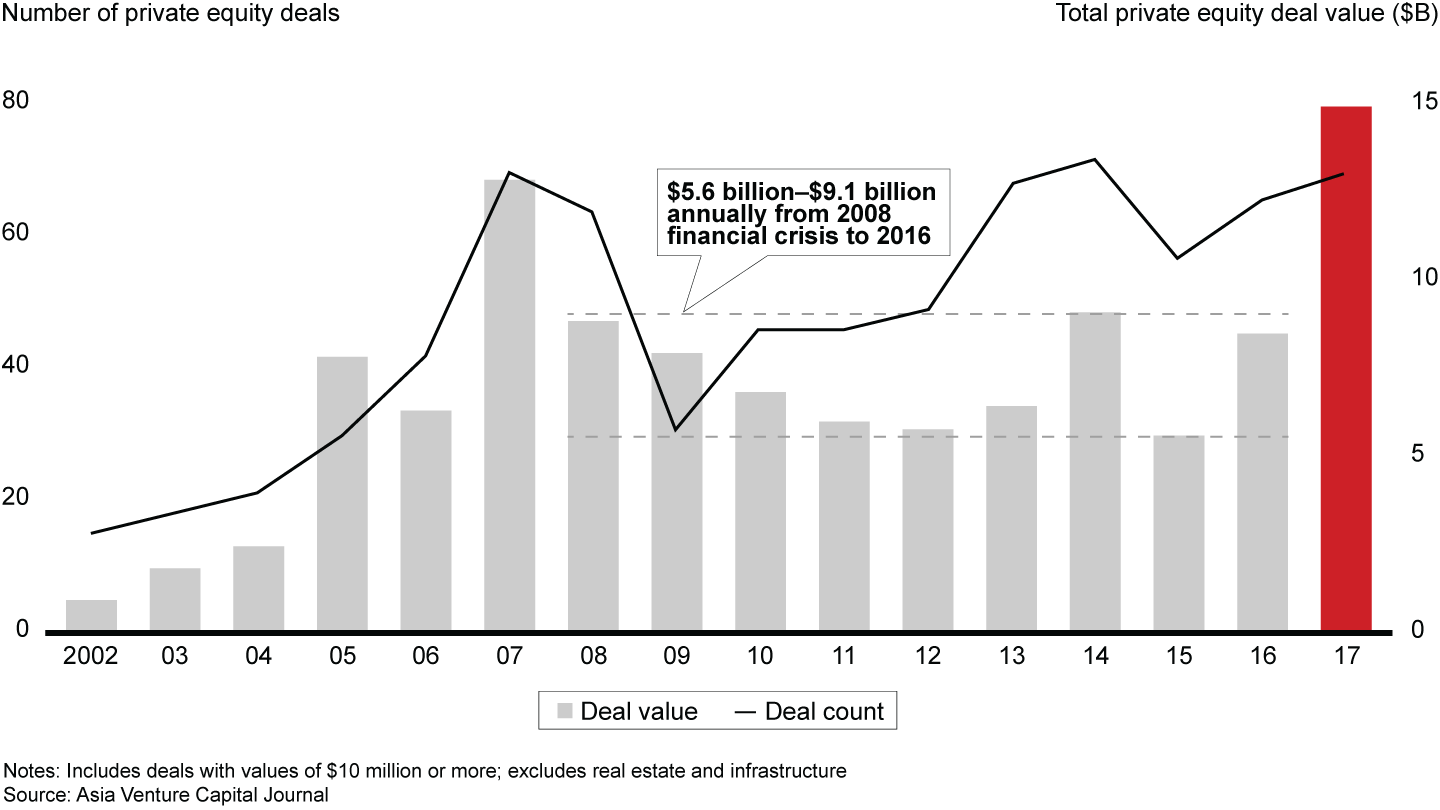
For once, all signposts point up. Technology companies attracted the bulk of new capital, rising to 40% of deal count in 2017 from 20% in 2014. Southeast Asia-dedicated funds’ dry powder—committed but unspent capital—has more than doubled since 2012. The region also has produced its first set of unicorns—new companies that rapidly achieve market valuations of $1 billion or more. Since 2012, 10 unicorns including Grab, Go-Jek and Traveloka have created a combined market value of $34 billion, ranking Southeast Asia No. 3 in the Asia-Pacific region, behind only China and India (see Figure 3).
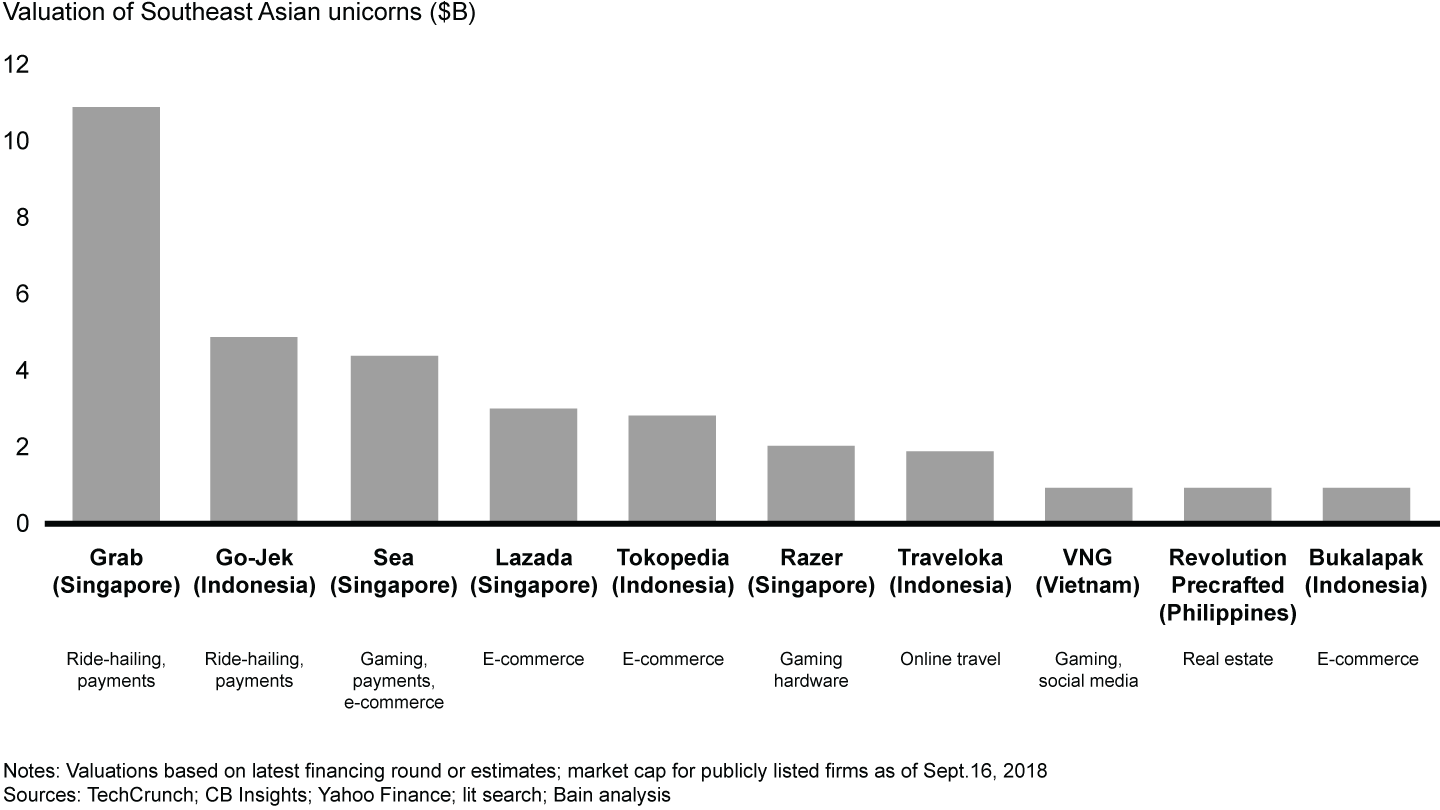
Can Southeast Asia sustain the new momentum? Bain & Company research shows the region’s investment ecosystem has developed critical mass and is entering a new phase of growth. We expect deal value over the next five years will total $70 billion—double the level of the previous five years—and that the region will produce at least 10 new unicorns by 2024.
It’s a jarring acceleration. Investment in Southeast Asia over the past decade has been surprisingly low, given the region’s average economic growth of 7% a year, a burgeoning middle class and a rapidly growing pool of digital natives—conditions that ignited a powerful investment dynamic in China and India. By contrast, private equity investment in Southeast Asia hovered for years between roughly $6 billion and $9 billion, leaving many private equity funds with regional offices in Southeast Asia wondering in 2016 when investment would take off. The tipping point took longer to reach, but years of solid economic growth, government support for start-ups, and perseverance by private equity funds created the conditions for a rapid transition to the next phase of growth.
Sustaining growth
Several factors are likely to contribute to higher investment activity across the region, including a steady influx of new venture capital and private equity participants. The number of active investors completing private equity transactions with deal values of $10 million or higher rose to 124 in 2017, a 45% increase from the previous five-year average. The pool of institutional investors, in particular, has expanded significantly. New investors are attracted by the region’s strong macroeconomic fundamentals, the chance to invest in emerging regional champions and a deepening secondary market for deals of all sizes. The mix includes a combination of local venture capital funds and private equity funds, sovereign wealth funds and global funds. One example is Navis Capital, which recently launched a $1.75 billion fund focused on Southeast Asia and Australia.
Another important catalyst for investment activity is the maturing bench of start-ups. More than 1,300 companies in Southeast Asia received a first round of seed, or Series A, financing since 2011, including 261 in 2017—five times the level of 2011. Overall, the region’s growing demand for capital has dovetailed with rising supply—a signal that company owners across the region are growing more receptive to venture capital and private equity investment.
Strong exit momentum and healthy returns are also contributing to a faster pace of investment by accelerating a healthy recycling of capital. In 2017, exit deal value rose to $16 billion, up 86% from the previous five-year average (see Figure 4). That virtuous investment cycle helps private equity fund managers feel more confident about raising new funds and putting capital to work. And as private equity funds expand their portfolios, they broaden the potential market for secondary transactions.
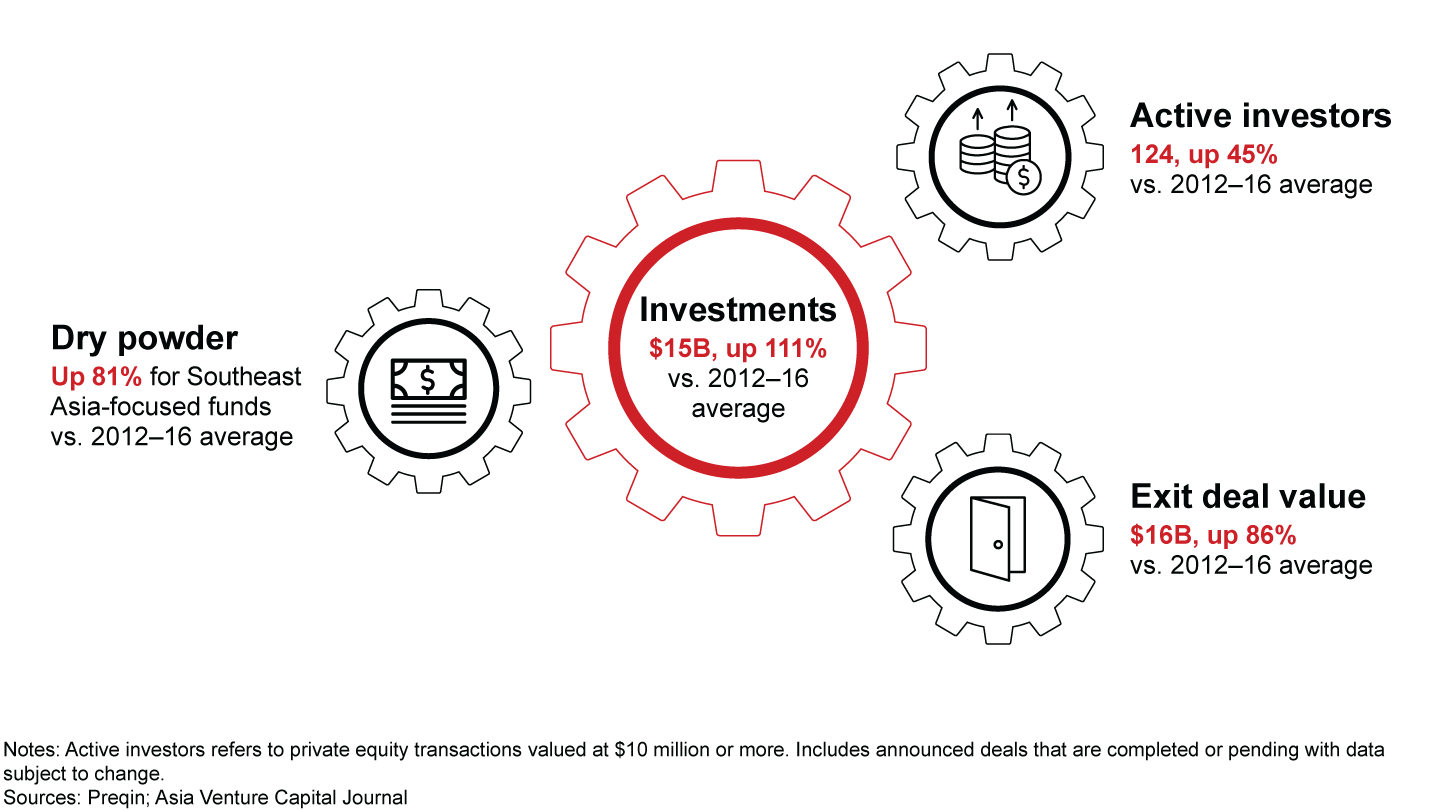
Progress by the 10-member Association of Southeast Asian Nations (ASEAN) creating a single Southeast Asian trade bloc continues to increase the attractiveness of the region for companies and investors. The existing trade bloc agreement reduces tariffs on goods and services and creates a common trade zone that operates more like a unified economy than a patchwork of national economies. Importantly, deeper integration of the ASEAN market encourages companies to expand across borders, accelerating their growth. GrabTaxi cofounders Anthony Tan and Hooi Ling Tan launched a ride-hailing app in Malaysia in 2012 and moved the company’s headquarters in 2014 to Singapore, where they received $340 million in several rounds of venture funding within the same year. Adding new services, they expanded rapidly across eight Southeast Asian countries, eventually buying out rival Uber’s regional business in 2018. Today, Grab is the region’s No. 1 ride-hailing business and its biggest start-up success story, with a market capitalization of $11 billion.
Even healthcare businesses, traditionally focused on local markets, are attracting capital to expand regionally. Fullerton Health, for example, now operates more than 500 clinics in eight Asia-Pacific countries, after being founded in 2011 with the acquisition of two corporate healthcare providers in Singapore. BookDoc, a three-year-old Malaysian start-up with venture funding, connects patients with healthcare providers and has built an online platform spanning five countries. Indonesian hospital group Siloam is one of its strategic partners.
Government initiatives have also played an important role supporting venture capital and vibrant start-up centers. Singapore’s Startup SG Founder program, for example, provides $3 in matching funds, up to $30,000, for every dollar that new entrepreneurs raise. Companies seeking to raise a second round of $2 million to $4 million receive one dollar in matching funds for every dollar they raise. In October 2017, the Monetary Authority of Singapore further simplified the authorization process for venture capital managers to help support start-up and growth-stage businesses. These moves and others have helped boost the percentage of Singapore-based start-ups that receive follow-on funding to the same level as start-ups in Europe. Governments throughout Southeast Asia are pursuing similar policies. In 2016, the government of Vietnam announced it would offer legal and financial support to 2,600 start-ups over the next 10 years through its accelerator, Vietnam Silicon Valley.
Though Singapore remains Southeast Asia’s investment hub, vibrant start-up ecosystems are emerging across the region. The number of companies in Indonesia raising a first round of funding in 2017 rose more than 300% from 2012. Together, Indonesia and Vietnam generated 20% of the region’s private equity deal value over the past five years, and that percentage is likely to grow. A recent Bain & Company survey showed nearly 90% of investors said the hottest Southeast Asian market outside of Singapore in 2018–19 will be Indonesia and Vietnam (see Figure 5).
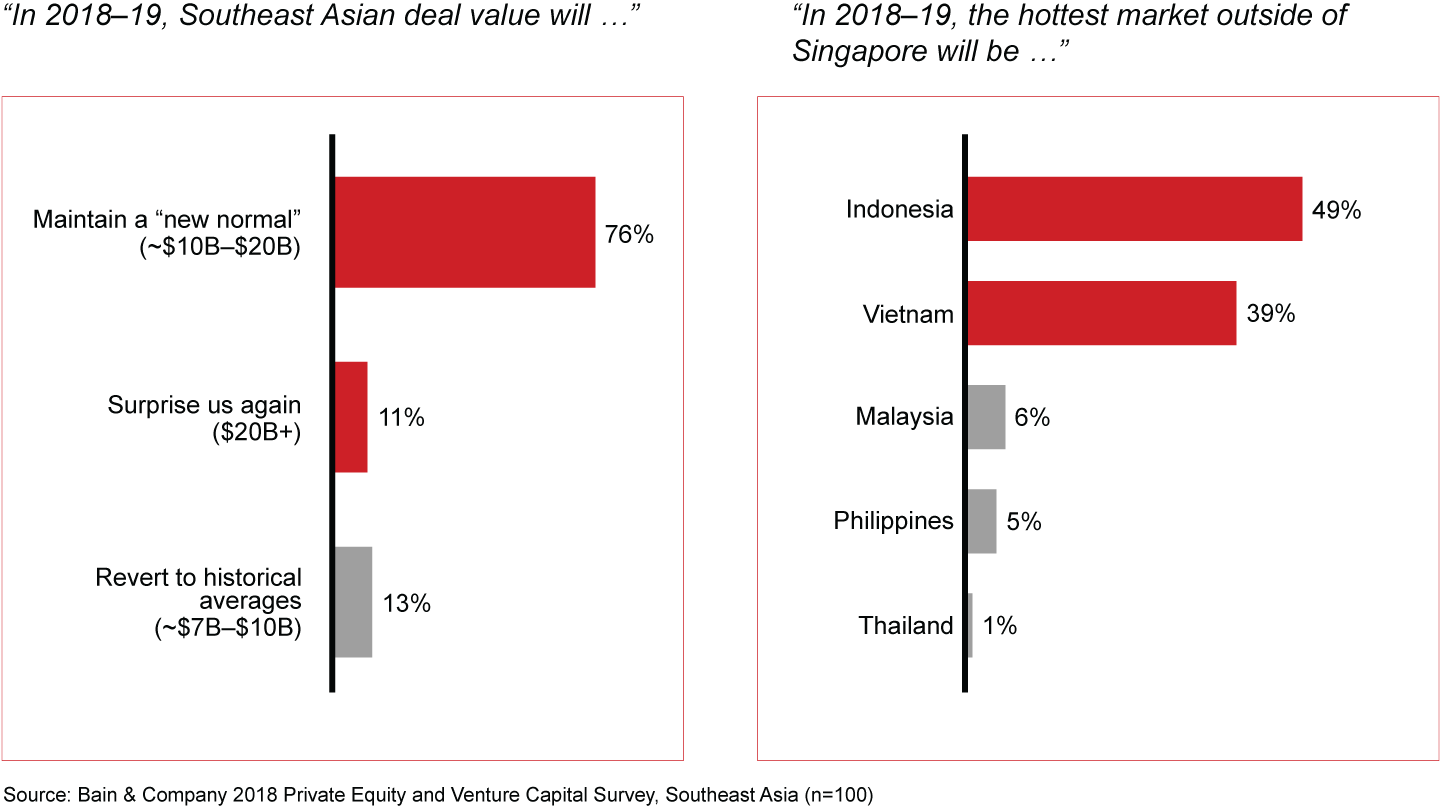
Strong investor interest in the region’s developing technology sector and other consumption-based industries is likely to help sustain higher levels of investment (see Figure 6). A 2017 study coauthored by Temasek and Google forecasts Southeast Asia’s $50 billion Internet economy will quadruple by 2025. We expect the technology sector to contribute 20% to 40% of deal value over the next five years. The financial technology sector, in particular, is expanding rapidly. Based on the valuations of leading fintech companies and strong investor interest in the sector, we expect two or three fintech unicorns to emerge by 2024. Information and communication technology firms are also growing rapidly and attracting larger pools of venture and private equity investment. More than 60% of top private equity and venture capital professionals in Southeast Asia predicted that technology would be the leading investment sector for 2018–19, according to a Bain survey (see Figure 7). In addition, we see a redoubling of investor interest in healthcare and education—sectors with significant long-term growth potential, but traditionally fragmented.
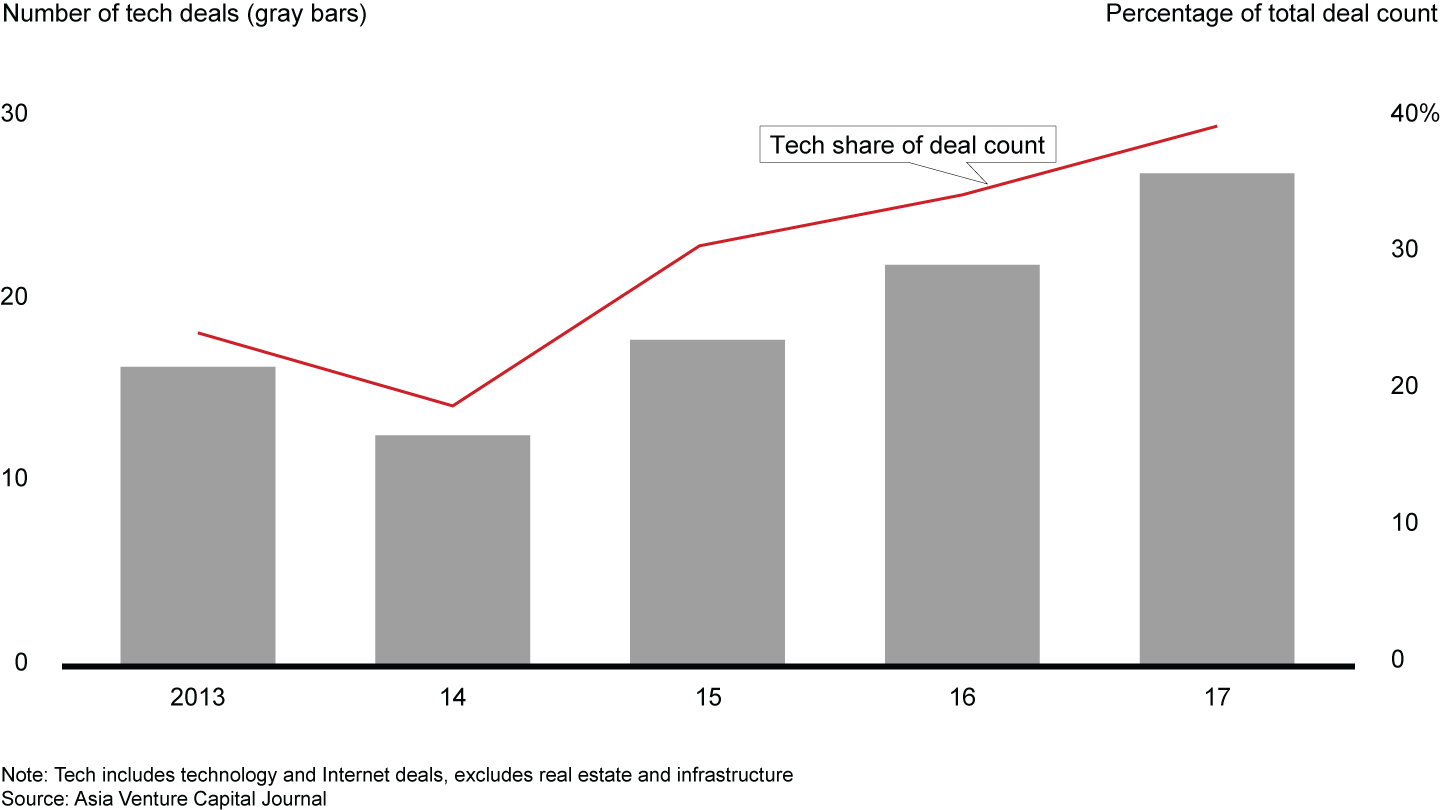

Navigating new terrain
Southeast Asia’s investment ecosystem has reached a crucial juncture as it deepens and broadens. We see stronger momentum for investment than in the past—and a growing number of success stories that will continue to attract more capital to the region. But competition is increasing and valuations are rising—the average multiple of enterprise value to EBITDA for private equity transactions is 17, the highest level in a decade (see Figure 8). At the same time, uncertainty about global economic growth is rising, and new technologies are accelerating disruption across many industries.
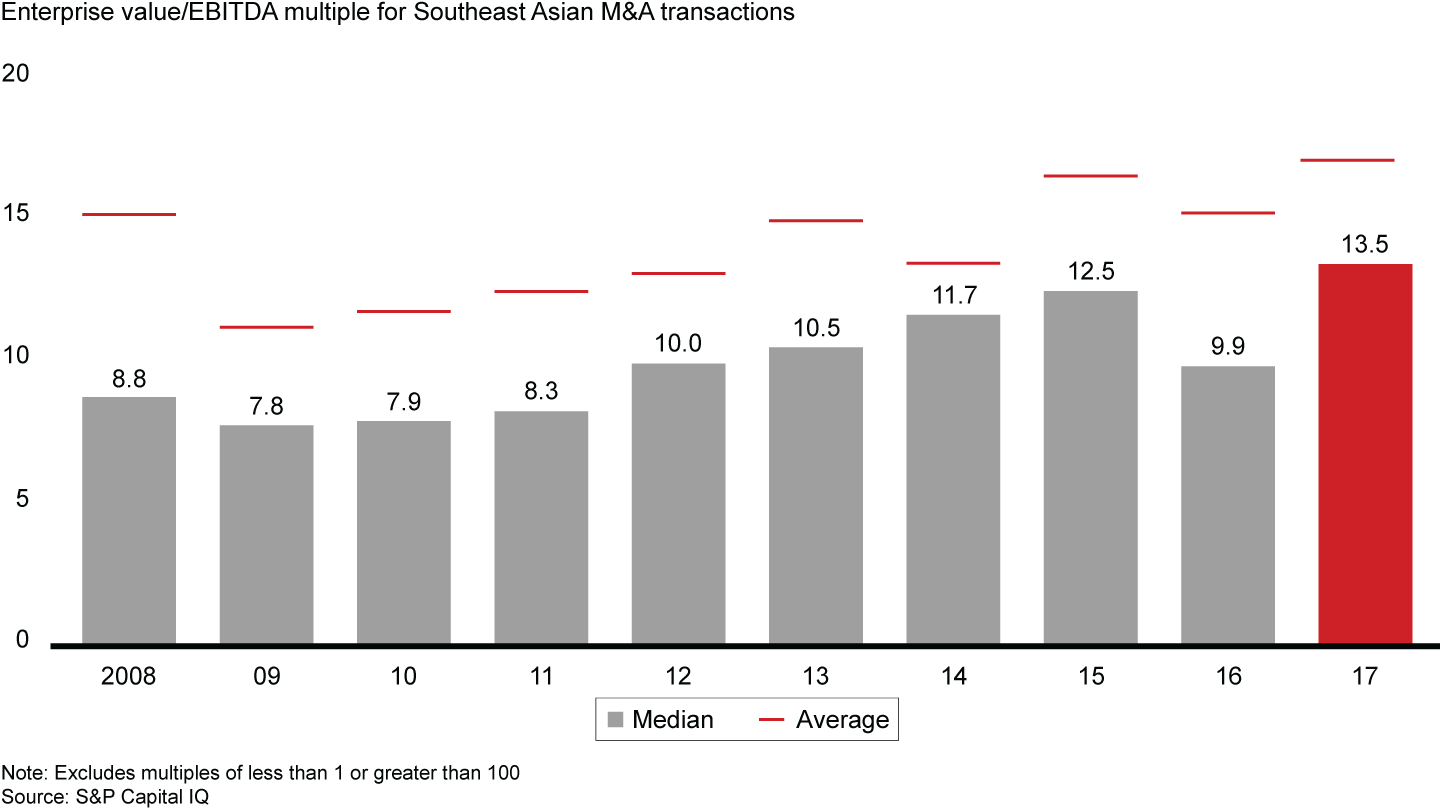
Skilled investors produce strong returns in a changing market by raising their game. They manage risks by increasing the value of their investments and propelling companies to a higher level of growth and performance. In the coming year, some sectors in Southeast Asia will face greater pressure than others. Investors targeting healthcare and medtech, for example, already face intense competition.
In our experience, investors who succeed in adding significant value to their companies share a common approach based on four principles.
Take an ASEAN perspective when evaluating deals. Smart investors already are making cross-border expansion part of their value-creation plans, as regulatory developments make it increasingly attractive. Companies that diversify across Southeast Asia grow faster and reduce the risk of relying on a single economy. They also benefit from the ongoing integration of these markets. Southeast Asia’s new cluster of unicorns spotlight the potential for spectacular value creation in the region.
Identify the right talent for the biggest roles. Bain research shows portfolio companies’ leadership is the greatest source of success or failure for value creation in Asia-Pacific investing—and talent is particularly scarce in Southeast Asia. However, many investors take an overly positive view of management teams early on. The most successful investors get the right leadership in place to deliver on the value-creation plan.
Build commercial excellence to boost organic growth. Accelerating top-line growth lifts profitability and magnifies exit multiples, but it’s hard to get right. Only 24% of general partners say they have met top-line expectations in most of their portfolio companies over the last few years, according to Bain & Company’s 2018 private equity survey. Leading PE firms make sure their portfolio companies build strength in commercial excellence by increasing customer segmentation, upgrading salesforce effectiveness, and revisiting pricing or product portfolio strategy. Those moves help management teams spot organic growth opportunities and generate big payoffs. Bain research shows the median return on investment is 20% to 30% higher when using a commercial acceleration program.
Make the most of digital technologies. Top global investors are helping management teams understand how new technologies are shifting their profit pools. Digital tools can help them take practical steps to improve their strategic position, commercial performance and cash flow. Portfolio companies that embrace digital strategies are better positioned to manage disruption and keep pace with rapidly changing markets. We expect digital disruption in Southeast Asian markets to continue moving faster than in Western markets. China overtook the US in total e-commerce sales because it had higher online and smartphone usage and fewer physical stores per capita. Technology giants Tencent and Alibaba are investing heavily in technology start-ups throughout Southeast Asia, betting the same dynamic will play out.
Investing in Southeast Asia is taking off, but new challenges will require investors to navigate adroitly. Those who build regional businesses, secure top talent, improve commercial excellence and harness digital technologies will be best positioned to produce the solid returns they’ve long been anticipating.
Suvir Varma is a senior advisor with Bain & Company’s Global Private Equity practice, based in Singapore. Alex Boulton is a principal in the firm’s Singapore office.







